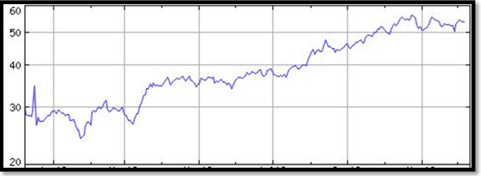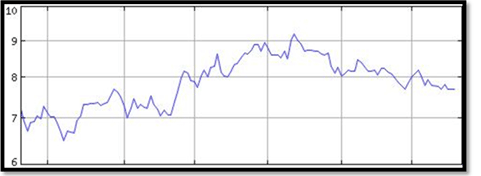We will now walk through an actual example of trading a call option and a put option. Going through these steps will give us exposure to how a trade really works, and the profit versus risk of each scenario.
Expecting a Bull Market
We all have those times when we get very bullish on a certain stock, or on the market as a whole. This trade will depict one of those times. The time frame is May 2009. The stock is Commonwealth Bank of Australia (CBA). The chart looks like this:
Our sentiment toward the market is bullish as we feel the worst of the economic downturn is over. We purchase call options on the stock CBA. The market has been volatile so this will inflate prices somewhat. We want to purchase a slightly ‘out of the money’ call option. Since the stock is trading at $37 we will purchase a contract with a strike price of $40. Also, we pick 6 months until expiration giving us enough time to let the stock rise.
This option will cost us $3.20 per share. Recall that each contract represents 1,000 shares so our outlay of cash is $3,200 plus transaction fees.
How Can We Can Profit?
Of course, we profit if the stock goes up. But under what circumstances will we gain?
- To exercise our options the stock needs to rise above $40 per share
- To profit by selling our contract, the option premium needs to rise quicker than time decay
How did the trade turn out?

The stock rose to $50 by the end of the fifth month of holding our call options contract. Perhaps by this point we are slightly nervous and decide to sell. With one month of time remaining on our contract, how much will we gain?
- If We Exercise the Contract
If we exercise the contract we gain the difference between the strike price and the current value of the shares. This relates to $10 per share profit. We essentially triple our investment and are now holding shares that we may need to sell on the open market.
- If We Sell the Options Contract
By selling our options contract we profit a little extra from the time value in the options contract. As well, we do not need extra capital to convert the contract into shares. The call options contract would be worth $10.18 per share if sold this way. Multiplied by 1,000 shares, this equates to $10,180, or $180 dollars extra as opposed to exercising our option.
How Much Can We Lose?
If the stock did not break $40 per share by expiration date, we would lose the full $3,200 invested as the option would expire worthless. We cannot lose any more than that amount.
We can recoup some of our losses even if the stock did not break $40 dollars. Imagine that three months into the trade, the stock is trading at $37 still not having moved a penny. Our contract has lost much in the way of time value, but is still worth a total of $1,900. We have the choice of losing $1,300 immediately, but potentially saving a further loss.
Another devastating loss will occur if the stock moves quickly in the wrong direction. If the stock fell to $30 in one swoop, our contract would only be worth $850 even with six months still remaining of time value.
Although there are many ways our options contract can diminish in value, we can never lose more than what we paid in premiums as long as we are purchasing, and not writing options.
Expecting a Bear Market
There are other times that we expect the market to fall. In these instances we can purchase put options that give us the right to buy at potentially lower prices, and sell at a higher price. The stock is Crown Limited (CWN). Here is the chart.
The price is roughly $8 per share and by September 1st, 2009, you see a small drop. You are anticipating a further drop due to a recessional after-shock so you purchase a very long term put options contract with a $5 strike price. The expiration date is December 12th, 2013, or four years away. The fair value of such an options contract is $1 per share or $1,000 total.
How We Can Profit?
We have four years to ride the market down. This gives us a massive time frame to trade in. We may profit if the price drops in the near term thus increasing the premium value of our put options contract, even if it has not hit the $5 strike price.
To exercise the contract, we profit by the amount the contract falls below the $5 strike price. If the contract fell to $3 by the end of our contract term, we would profit $2 per share which is double our investment.
The most we could gain is if the company fell to zero, whereby our options contract would be worth $5 per share, or five times the value of our investment.
How Can We Lose?
If the stock continues to go up, the share price will pull further and further away from the strike price thus decreasing our options premium.
If the stock stagnates, the time value portion of our put option contract will slowly be eroded.
Even if the stock goes down we may lose if:
- we are trying to exercise our option but the price doesn’t go below $5 per share.
- we try to sell the put option but the lost value of time exceeds the price drop.
If we do decide to exercise the option, $4 per share would be our breakeven point whereby we recoup $1 per share profit.
What Really Happened?
As of December 2009, the price rose, and then dropped. At one point our options contract dropped to being worth only 85 cents per share, or $850 total. This loss of $150 was reversed as the share prices began to drop thus raising our put options premium value.

Interestingly, although the theoretical option pricing calculator has this put options contract worth $1 per share, the market value is only 85 cents. This highlights how market expectation or implied volatility can influence options prices. Although, we still have four years to find out what will really happen.